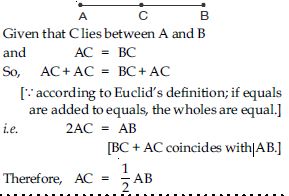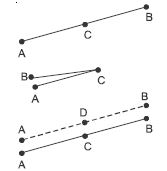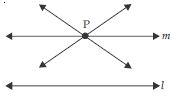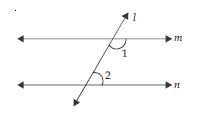Question 1:
Which of the following statements are true and which are false? Give reasons for your
answers.
Only one line can pass through a single point.
- TRUE
- FALSE
Answer:
False
Correct statement:
Infinitely many lines can pass through a single point.
This is self evident and can be seen visually by the student as follows:
Question 2:
Which of the following statements are true and which are false? Give reasons for your
answers.
There are an infinite number of lines which pass through two distinct points.
- TRUE
- FALSE
Answer:
False, because the given statement contradicts the postulate I of the Euclid that assures that there is a unique line that passes through two distinct points.
Through two points P and Q a unique line can be drawn.
Question 3:
Which of the following statements are true and which are false? Give reasons for your
answers.
A terminated line can be produced indefinitely on both the sides.
- TRUE
- FALSE
Answer:
True
Evidence: According to Euclid’s postulate 2; A terminated line can be produced indefinitely.
Question 4:
Which of the following statements are true and which are false? Give reasons for your
answers.
If two circles are equal, then their radii are equal.
Answer:
True
Evidence:
According to the axiom 4 of Euclid; that “the things which coincide with one another are
equal to one another”. If we superimpose the region bounded by one circle on the other, then
they coincide. So, their centres and boundaries coincide. Therefore, their radii will
coincide.
Question 5:
Which of the following statements are true and which are false? Give reasons for your
answers.
In fig., if AB = PQ and PQ = XY, then AB = XY.
- TRUE
- FALSE
Answer:
True.
Evidence: Euclid’s axiom 1 states that the things which are equal to the same thing are
equal to one another.
Question 6:
Give a definition for each of the following terms. Are there other terms that need to be
defined first? What are they, and how might you define them?
parallel lines
Answer:
Parallel straight lines are straight lines which, being in the same plane and being produced
indefinitely in both directions, do not meet one another in either direction.
Other term involved is the “plane”. We keep the plane as undefined term. The only thing is
that we can represent it intuitively or explain it with the help of physical model.
Question 7:
Give a definition for each of the following terms. Are there other terms that need to be
defined first? What are they, and how might you define them?
perpendicular lines
Answer:
Perpendicular lines. When a straight line set up on a straight line makes the adjacent angles
equal to one another, each of equal angle is right and the straight line standing on the
other is called a perpendicular to that on which it stands. The other terms that need to be
defined first is (1) angle (2) adjacent angles (3) right angle. Let us define these:
(1) Angle. A plane angle is the inclination to one another of two lines in a plane which
meet one another and do not lie in a straight line.
(2) Adjacent angles. The two angles with the same vertex, one arm common and other arms
lying on the opposite sides of the common arm are called adjacent angles.
(3) Right angle. An angle equal to one quarter of a complete angle is called a right angle.
Question 8:
Give a definition for each of the following terms. Are there other terms that need to be
defined first? What are they, and how might you define them?
line segment
Answer:
Line segment. A line segment which extends indefinitely in both irections gives a line.
Other term involved is line. We keep the line as undefined term. The only thing is that we
can represent it intuitively or explain it with the help of physical model.
Question 9:
Give a definition for each of the following terms. Are there other terms that need to be
defined first? What are they, and how might you define them?
radius of a circle
Answer:
Radius of a circle. A line segment joining the centre to any point on the circle is called
the radius of the circle.
Other terms that need to be defined first are:
(1) Circle (2) Centre.
Let us define these:
(1) Circle. A circle is a closed curve on a plane, all points on which are at the same
distance from a fixed point within it.
(2) Centre of circle. The fixed point from which all the points on a circle are equidistant
is called its centre.
Question 10:
Give a definition for each of the following terms. Are there other terms that need to be
defined first? What are they, and how might you define them?
Square
Answer:
Square. Of quadrilateral figures, a square is that which is both equilateral and rightangled.
Other terms that need to be defined first are (1) equilateral (2) right angle. Let us define
these.
(1) Equilateral. A figure having all its sides equal is called an equilateral.
(2) Right angle. An angle equal to one quarter of a complete angle is called a right angle.
Question 11:
Consider two ‘postulates’ given below:
(i) Given any two distinct points A and B, there exists a third point C which is in between
A and B.
(ii) There exist at least three points that are not on the same line.
Do these postulates contain any undefined terms? Are these postulates consistent? Do they
follow from Euclid’s postulates? Explain.
Answer:
There are several undefined terms which are to be listed by a student. These two postulates
(i) and (ii) are consistent because they deal with two different situations.
Postulate (i) states that given two points A and B, there is a point C lying on the line in
between them.
Postulate (ii) states that for given two points A and B, we can take point C not lying on the line through A and B.
Hence we observe that the postulates do not follow from Euclid’s postulate. However they follow from Euclid’s axiom that follow from Euclid’s postulate (1) that “for given two distinct points there is a unique line that passes through them.” See fig.
Question 12:
Answer:
Question 13:
In Previous Question, point C is called a mid-point of line segment AB. Prove that every line segment has one and only one mid-point.
Answer:
Let C and D be the two mid-points of line
segment AB.
So, according to Euclid’s axiom (4) when line is folded about point C we observe that part
BC superimposes over the part AC.
It implies that
AC = BC ... (i)
Similarly, D is the mid-point of AB implies that
AD = BD ... (ii)
we have AB = AB
or AC + BC = AD + BD
or AC + AC = AD + AD
[Using (i) and (ii)]
or 2AC = 2AD
or AC = AD ... (iii)
When we superimpose AD over AC and BD over BC we find that D exactly lies over C. It implies
that D and C are not two different points but the same.
Hence, we conclude that mid-point of a line segment is unique.
Question 14:
In fig., if AC = BD, then prove that AB = CD.
Answer:
Given that
AC = BD ... (i)
AC = AB + BC
[Point B lies between A and C.] ... (ii)
BD = BC + CD
[Point C lies between B and D.] ...(iii)
Substituting (ii) and (iii) in (i), we get:
AB + BC = BC + CD
Subtracting BC from both sides, we get:
AB + BC – BC = BC + CD – BC
= BC – BC + CD
So, AB = CD
[_ if equals are subtracted from equals, the remaining are equal.]
Question 15:
Why is Axiom 5, in the list of Euclid’s axioms, considered a ‘universal truth’? (Note that the question is not about the fifth postulate.)
Answer:
Euclid’s Axiom 5 states that “The whole is greater than the part.”
Since this is true for anything in any part of the world.
So, this is a universal truth.
Question 16:
How would you rewrite Euclid’s fifth postulate so that it would be easier to understand?
Answer:
There are several easy equivalent versions of Euclid’s fifth postulate. Playfair’s axiom is one of the other equivalent versions of Euclid’s fifth postulate which is easily understandable. According to it,
For every line l and for every point not lying on l, there exists a unique line m passing
through point P and is parallel to l.
Clearly, if all lines passing through the point P, only line m is parallel to line l.
Question 17:
Does Euclid’s fifth postulate imply the existence of parallel lines? Explain.
Answer:
Yes. Euclid’s fifth postulate is valid for parallelism of lines because if a straight line l falls on two straight lines m and n such that sum of the interior angles on one side of l is two right angles, then by Euclid’s fifth postulate the line will not meet on this side of l. Next, you know that the sum of the interior angles on the other side of line l will also be two right angles. Therefore, they will not meet on the other side also. So, the lines m and n never meet and are, therefore, parallel.













